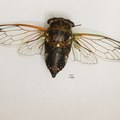| Dog-day cicada | |
|---|---|
 | |
 | |
| Exuvia | |
| Scientific classification | |
| Kingdom: | Animalia |
| Phylum: | Arthropoda |
| Class: | Insecta |
| Order: | Hemiptera |
| Suborder: | Auchenorrhyncha |
| Family: | Cicadidae |
| Genus: | Neotibicen |
| Species: | N. canicularis |
| Binomial name | |
| Neotibicen canicularis (Harris, 1841) | |
 | |
| Synonyms | |
Tibicen canicularis | |
Neotibicen canicularis, commonly called the dog-day cicada, dog-day harvestfly, or heatbug, is a species of annual cicada.





